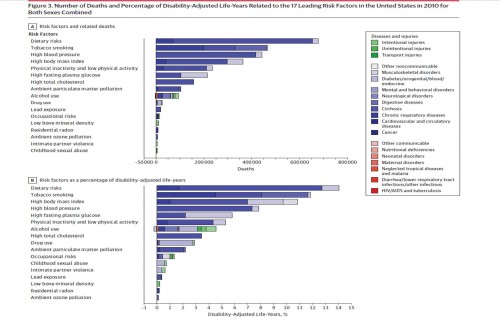The following chart is from a the JAMA paper The State of US Health, 1990-2010 Burden of Diseases, Injuries, and Risk Factors, by an estimated 145 authors.* Aaron posted on this paper when it was in online-only form. He posted a chart that’s worth a look if you missed it. Below is a different chart. (Click to enlarge, of course. I know, even then it is hard to read. Best I could do.)
The chart shows the factors that contribute to death and disability-adjusted life years. Of course, each factor does so via some condition, which is indicated in each bar by color. I can’t even take in all the details, so I’m going for the gestalt. My take away is that a lot of potentially modifiable lifestyle factors (diet, smoking, body mass, physical activity, alcohol and drug use, etc.) make major contributions to death and disability. This is not news,** but it is important.
Let us note some caveats, as conveyed in an accompanying editorial by Harvey Fineberg.***
The component of the study dealing with risk factors is problematic in other ways. For instance, for mortality, there is a natural sum of all disease-specific deaths; namely, the total number of deaths. No such natural limit restricts the sum of risk factor contributions from studies of relative risk, and the authors acknowledge that these may add to more than 100%. In the case of dietary risk factors, 14 components of diet have been treated as independent risk factors. Although this is a tribute to the richness of the literature about specific dietary exposures and risk of premature death, this approach overlooks likely codependence among at least some of the dietary components and, thus, tends to overstate the relationship between diet and mortality. Nevertheless, even taking these calculations with a pinch of salt, the potential for dietary changes to improve health in the United States is impressive.
Risk factor analyses will become more useful over time as epidemiologists, statisticians, biologists, and other scientists are able to map the several layers of causal factors onto the expression of illness and its consequences. In this way, genetic, metabolic, physiologic, behavioral, environmental, and social factors will be traced through defined pathways to disease and premature mortality. This is a huge undertaking, the epidemiologic equivalent of the grand unified theory of forces in particle physics. Even partial elucidation of these epidemiologic interactions promises to reveal powerful ways to prevent disease and premature mortality.Importantly, this integrative research objective requires lines of inquiry at both the social and biological levels. Trying to understand the causation of disease using only one of these lines of research is like trying to clap with one hand.
* I’m not kidding. Click through and count them yourself.****
** Few things in health care or anything for that matter are news.
*** Always read the editorials. They are usually very good, and often more readable than the papers on which they comment.
**** Bet you didn’t think I’d go to a four-star footnote, did you?



